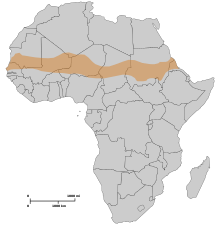Famine in the Sahel Zone (1970s and 1980s)
The famine in the Sahel in the 1970s and 1980s was the result of drought , affecting around 50 million people and killing an estimated one million people.
causes
The drought was due to both natural and man-made factors. There are natural climate fluctuations in the Sahel zone , within the framework of which the annual rainfall can sometimes largely fail. Human influences include the cutting down of forests , overgrazing and overexploitation of agricultural land. This aggravated the problem of desertification ( desertification ). Another reason for the famine in the Sahel is that more and more locusts are invading the area in swarms and grazing the fields.
In addition, the phenomenon of global blackout has also been considered a possible contributing cause since the twentieth century . This phenomenon is triggered by air pollution in Europe and North America and leads to increased cloud formation, but at the same time to lower evaporation and thus to reduced precipitation.
Effects
The famine in the Sahel had far-reaching consequences. Numerous people left the affected countries as environmental refugees and moved to more southern, more precipitous countries such as the Ivory Coast . In general, rural exodus increased within the affected countries, which also led to changes in the traditional social structure.
The famine in Darfur / Sudan
The famine in the 1980s - particularly in 1984 and 1985 - is seen by some as one of the causes of the current Darfur conflict in the Darfur region in western Sudan . There, drought and famine intensified the contrast between “ Arab ”, nomadic cattle breeders and settled black African farmers in the competition for scarce natural resources.
Change of government
In Niger , the 1974 famine contributed to the overthrow of the first president, Hamani Diori - who was accused of corruption and inefficient use of international aid - by Seyni Kountché .
There were also changes of government in Mali , Mauritania and Chad , which were favored, among other things, by the drought and famine and the resulting dissatisfaction of significant sections of the population.
See also
Individual evidence
- ↑ West Africa: Locusts Threaten Next Harvest on Development Policy Online July 3, 2012, accessed September 6, 2018.

